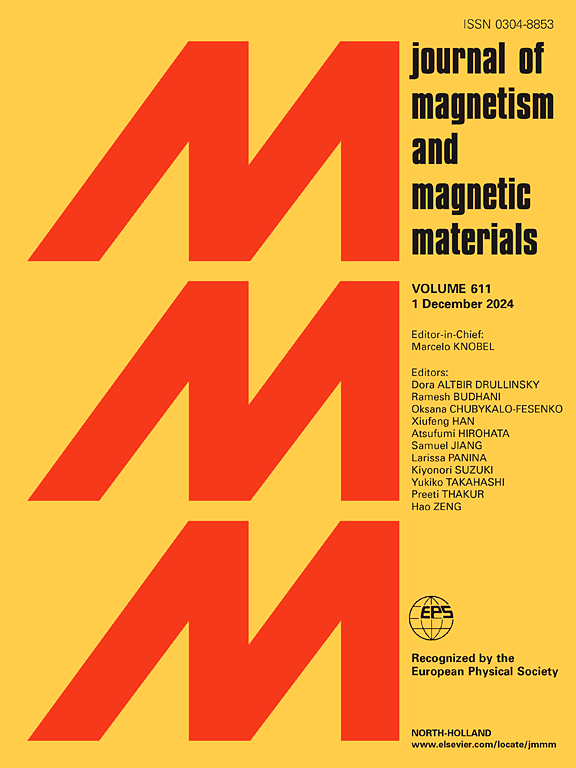Room temperature ferromagnetism in ceria nanorods and nanosheets: Influence of morphology and defects
IF 2.5
3区 材料科学
Q3 MATERIALS SCIENCE, MULTIDISCIPLINARY
引用次数: 0
Abstract
This study investigates the structural, chemical, and magnetic properties of cerium oxide (CeO2) nanoparticles (NPs) with distinct morphologies, including nanorods (CeO2 NR), nanosheets (CeO2 NS), and polyhedral structures (CeO2 poly). X-Ray Diffraction (XRD) analysis revealed significant variations in lattice microstrain and dislocation density, with CeO2 NR exhibiting the highest values, followed by CeO2 NS and CeO2 poly. Transmission Electron Microscopy (TEM) micrographs confirmed the well-defined morphologies of the NPs, with CeO2 NR showing an average width of 6 nm and length of 39 nm, while CeO2 NS and CeO2 poly presented average diameters of 14 nm and 27 nm, respectively. X-Ray Photoelectron Spectroscopy (XPS) analysis indicated that CeO2 NR had the highest concentration of Ce3+ ions and oxygen vacancies, which correlated with its enhanced magnetic susceptibility and polaron magnetization. In contrast, CeO2 poly exhibited a more stable structure with lower defect density, resulting in weaker magnetic properties. CeO2 NS presented intermediate characteristics, structural distortion and magnetic behavior. The formation of small polarons and bound magnetic polarons (BMPs) in CeO2 NR, resulted by high tensile strain and oxygen vacancy concentration, was identified as a key factor in promoting room-temperature ferromagnetic (RTFM) ordering. These findings highlight the critical role of morphology in tailoring the properties of CeO2 nanoparticles, offering valuable insights for the design of advanced functional materials for applications in spintronics, catalysis, and energy storage.
室温下二氧化铈纳米棒和纳米片的铁磁性:形貌和缺陷的影响
本研究研究了不同形态的氧化铈纳米粒子(NPs)的结构、化学和磁性能,包括纳米棒(CeO2 NR)、纳米片(CeO2 NS)和多面体结构(CeO2 poly)。x射线衍射(XRD)分析结果表明,CeO2 NR的晶格微应变和位错密度变化较大,其次是CeO2 NS和CeO2 poly。透射电子显微镜(TEM)证实了纳米颗粒的形态,CeO2 NR的平均宽度为6 nm,长度为39 nm, CeO2 NS和CeO2 poly的平均直径分别为14 nm和27 nm。x射线光电子能谱(XPS)分析表明,CeO2 NR具有最高浓度的Ce3+离子和氧空位,这与其磁化率和极化子磁化强度增强有关。相比之下,聚CeO2表现出更稳定的结构和更低的缺陷密度,从而导致更弱的磁性能。CeO2 NS表现出中间特性、结构畸变和磁性行为。高拉伸应变和氧空位浓度导致CeO2 NR中小极化子和束缚磁极化子(BMPs)的形成是促进室温铁磁有序的关键因素。这些发现强调了形貌在定制CeO2纳米颗粒性能中的关键作用,为设计用于自旋电子学、催化和能量存储的先进功能材料提供了有价值的见解。
本文章由计算机程序翻译,如有差异,请以英文原文为准。
求助全文
约1分钟内获得全文
求助全文
来源期刊

Journal of Magnetism and Magnetic Materials
物理-材料科学:综合
CiteScore
5.30
自引率
11.10%
发文量
1149
审稿时长
59 days
期刊介绍:
The Journal of Magnetism and Magnetic Materials provides an important forum for the disclosure and discussion of original contributions covering the whole spectrum of topics, from basic magnetism to the technology and applications of magnetic materials. The journal encourages greater interaction between the basic and applied sub-disciplines of magnetism with comprehensive review articles, in addition to full-length contributions. In addition, other categories of contributions are welcome, including Critical Focused issues, Current Perspectives and Outreach to the General Public.
Main Categories:
Full-length articles:
Technically original research documents that report results of value to the communities that comprise the journal audience. The link between chemical, structural and microstructural properties on the one hand and magnetic properties on the other hand are encouraged.
In addition to general topics covering all areas of magnetism and magnetic materials, the full-length articles also include three sub-sections, focusing on Nanomagnetism, Spintronics and Applications.
The sub-section on Nanomagnetism contains articles on magnetic nanoparticles, nanowires, thin films, 2D materials and other nanoscale magnetic materials and their applications.
The sub-section on Spintronics contains articles on magnetoresistance, magnetoimpedance, magneto-optical phenomena, Micro-Electro-Mechanical Systems (MEMS), and other topics related to spin current control and magneto-transport phenomena. The sub-section on Applications display papers that focus on applications of magnetic materials. The applications need to show a connection to magnetism.
Review articles:
Review articles organize, clarify, and summarize existing major works in the areas covered by the Journal and provide comprehensive citations to the full spectrum of relevant literature.
 求助内容:
求助内容: 应助结果提醒方式:
应助结果提醒方式:


